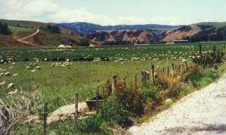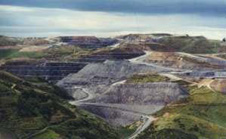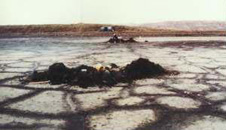 1. Island Block alluvial gold mine (near Roxburgh) after rehabilitation. The mine was developed in an old channel of the Clutha River (flats in foreground) which was abandoned thousands of years ago. During the mining operation, a hole more than 20 metres deep was dug progressively downstream, and the excavated gravel was used to backfill the hole after the gold was extracted.
1. Island Block alluvial gold mine (near Roxburgh) after rehabilitation. The mine was developed in an old channel of the Clutha River (flats in foreground) which was abandoned thousands of years ago. During the mining operation, a hole more than 20 metres deep was dug progressively downstream, and the excavated gravel was used to backfill the hole after the gold was extracted.  2. Macraes hard-rock gold mine showing the main features of a large scale open pit. The excavated pit is on the left (each bench is 10 metres high). Waste rock from the pit is piled on the skyline, with older piles grassed over. The processing plant is centre right, and tailings from this plant are discharged as a slurry into a large dam (far right and beyond this view).
2. Macraes hard-rock gold mine showing the main features of a large scale open pit. The excavated pit is on the left (each bench is 10 metres high). Waste rock from the pit is piled on the skyline, with older piles grassed over. The processing plant is centre right, and tailings from this plant are discharged as a slurry into a large dam (far right and beyond this view).  3. Dried mine tailings at the Macraes mine soon become sufficiently stable to walk on. They have the consistency of clay, with a hard dry crust on top, and soft cheese texture at depth. These tailings are so fine grained and resistant to gain or loss of water that they should remain unchanged for hundreds of years provided they are kept damp after rehabilitation with a covering layer of vegetated soil.
3. Dried mine tailings at the Macraes mine soon become sufficiently stable to walk on. They have the consistency of clay, with a hard dry crust on top, and soft cheese texture at depth. These tailings are so fine grained and resistant to gain or loss of water that they should remain unchanged for hundreds of years provided they are kept damp after rehabilitation with a covering layer of vegetated soil.
Environmental standards of Otago's pioneering Europeans were low, and mining activity was essentially unconstrained. The scars still remain from this era because revegetation in Central Otago is slow, especially where the thin soil has been sluiced away. Alluvial mining was the main culprit then, as this occurred at the largest scales, in surface gravels. The operations also undoubtedly muddied the waters downstream, although any consequent siltation problems have since been rectified naturally by flooding. Hard-rock mining was on smaller scale and was mostly underground, so the only visual evidence now is scattered mine waste piles which have largely become overgrown.
The relative visual impacts of alluvial and hard rock mining today are reversed from last century. Alluvial operations, while large, have developed an impressive reputation for land rehabilitation. It is difficult to find where the large alluvial mines have been only one year after closure. In contrast, the Oceana Gold Ltd Macraes mine is characterised by large waste rock piles which dominate the skyline in the mine vicinity, and deep open pits collectively several kilometres long. The waste rock piles will ultimately be grassed over and the relief will soften in time so that they will be less obtrusive, but the skyline will be changed permanently. This is typical of large open cast mines anywhere in the world. The pits may be filled with tailings from the processing plant and be grassed over, or filled with water to become lakes.
The chemical legacy from hard rock mining may be more significant in the long term. One of the sulphide minerals which encloses the gold in hard-rock mines is arsenopyrite (FeAsS), which contains arsenic. Arsenic is non-toxic when combined in that mineral, but can be toxic when released from the mineral during surface oxidation. Oxidation causes the arsenic to dissolve in any groundwater and enter streams and rivers. This oxidation is enhanced by sulphuric acid created when the accompanying pyrite is oxidised.
Oxidation of arsenopyrite is a natural process in the upper 20 metres of the schist basement, and ultimately all the arsenopyrite in Otago will be decomposed to send the arsenic to the sea. However, this natural process is slow and stream waters are safe to drink even adjacent to natural exposures of gold-bearing quartz veins. Mining accelerates arsenopyrite oxidation by breaking up the rock and allowing entry of oxygen-bearing water. Hence, old underground mines channel oxygen-bearing water through arsenopyrite-bearing rock, and water discharging from those mines typically have 100 times the recommended drinking water maximum arsenic content.
Crushed tailings rock from processing plants are also potential arsenic sources. Last century, these tailings were discharged directly into the nearest stream and were washed to the sea. Only small remnants of these tailings remain and these, while acidic and potentially toxic, are small enough for arsenic to be readily diluted downstream. At Macraes, the tailings are carefully managed, and they are impounded behind large dams where thay are kept chemically neutral and discharges are prevented. The long-term (500 years?) safety of these tailings dams has been a major environmental concern throughout the mine planning stages.
Related
- Origins of the gold
- Alluvial mining
- Hard-rock mining
- Economies of Scale
- Environmental aspects of mining
- Gold at St Bathans
- Gold at Gabriels Gully
- Gold at Alexandra and Ophir
